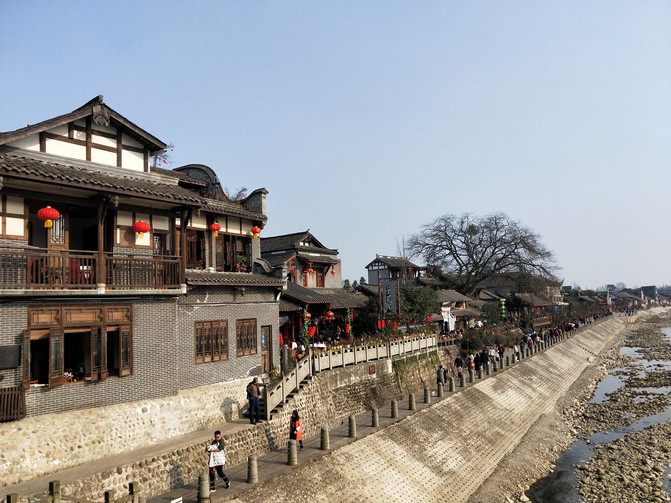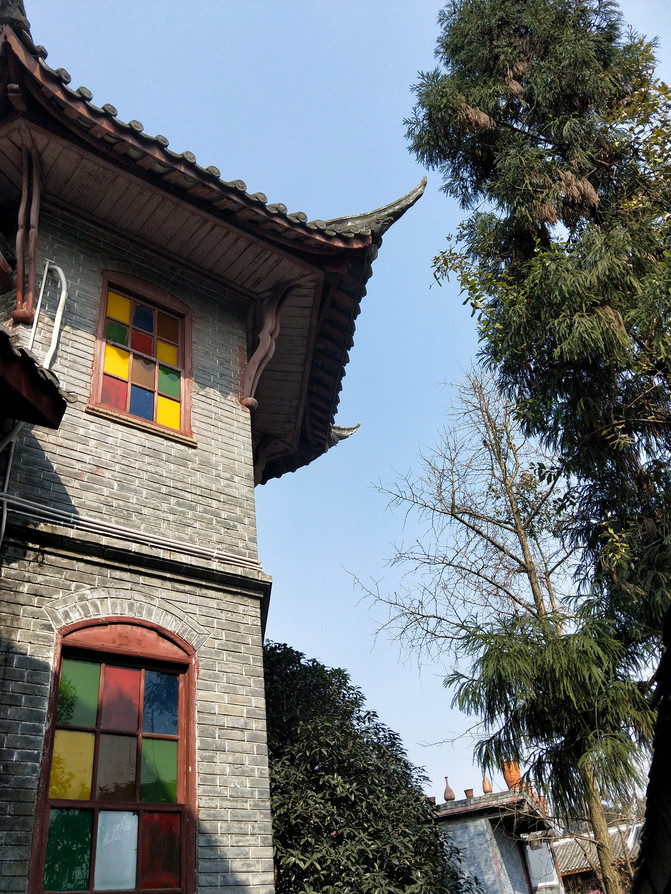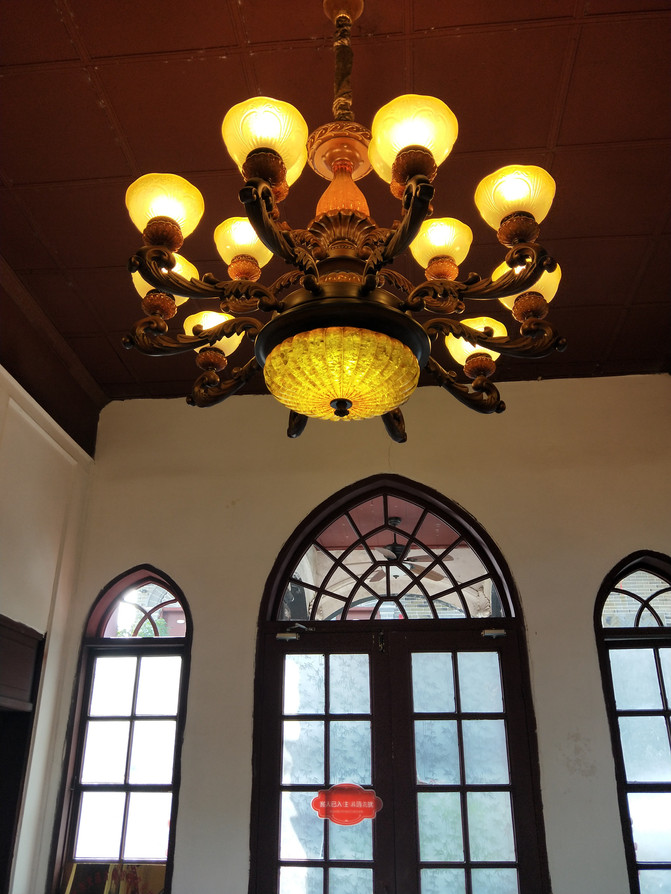Part 5 of Self-driving Tour Home for the New Year--Pinming Tea in Yuantong Old Street
[Ancient Huaiyuan Town]
The most simple small city in the suburbs of Chengdu is home to countless ancient towns. Every time I choose one or two to visit. This time I chose Yuantong in Chongzhou. When I saw Huaiyuan nearby, I stopped by for a stroll.

Huaiyuan is located in the west of Yuantong Ancient Town. It is not big and has many buildings dating from the Qing Dynasty and the Republic of China. Most of the buildings in the ancient town were built during the Qing Dynasty and the Republic of China, while maintaining the pattern of four doors and four streets.

This is an ancient town delayed by delicious food, and its unpretentious architectural structure still retains its previous appearance. Life is changing and the people you come and go with are changing, but Huaiyuan Ancient Town has never changed.



Walking on the old street of Huaiyuan Ancient Town, time seems to stop here, as if it has returned to ancient times! An ancient town with a history of 1600 years, it sings the world in different forms. Strolling through these old streets, looking at the gloomy, unpretentious planks, railings, and gable buildings. There is no noise here. There is no controversy, which makes people sigh at the simple and natural beauty of this peaceful place.


Huaiyuan's most famous "three edits": rattan weaving, brown weaving, and bamboo weaving. Almost every family has skilled craftsmen. In the hands of those old people, rattan, brown, and bamboo became a work of art and were displayed along the street, dazzling people.

I specially drove here to eat all the three treasures of Huaiyuan: leaf cake, parfait, and tofu curtains. Although the streets are lively, life behind the streets is still peaceful and simple.

Huaiyuan Three Wonders 'Leaf Baba
The first of the three wonders is to take a bite of Ye 'er cake wrapped in sesame seeds, sesame oil, white sugar and peanuts. It tastes soft, fragrant and glutinous, and it is unforgettable.

The parfait of Huaiyuan Three Wonders
Its color is white and slightly yellow, moist and soft, elastic, and it is loose and melted into dregs. When you eat it, you can taste an oily but not greasy feeling, with endless aftertaste.

The tofu curtain of Huaiyuan Three Wonders
Grind beans, boil soy milk, and order stewing to make tofu. However, to make tofu curtains, you must constantly stir, filter water layer by layer, cool, wrap, and ferment on a bamboo curtain before soy milk forms tofu to form a unique taste.

[Yuantong Old Street Pinming Tea]
He left Huaiyuan and then went to Yuantong Ancient Town. Yuantong Ancient Town has historically been an important dock on the Wenjing River. It was once prosperous for a time. It is appropriate to use "ancient" to summarize Yuantong Ancient Town.

Take a nap in the penthouse next to the old stone arch bridge at the end of half the street, watch the river flow by you, imagine the prosperity of Yuantong 1600 years ago, which makes people sigh that "the deceased are like a husband"...

Yuantong jokingly calls it "Little Chengdu", with rows of green-tiled houses living next to the river, hanging towers next to stone arch bridges, and ancient stone roads, giving a flavor of a Jiangnan water town.

Since ancient times, there have been three unique things. One unique thing is the former residence of Huang's family with a deep courtyard and a courtyard;

The second unique is the Yongli Suspension Bridge in Lao Street, Lao Bridge, Qing Jiaqing Year;

The three wonders are the micro-version of the "Qingming Festival Riverside Map" where the Three Rivers converge.

An old street, accompanied by a river, is peaceful and peaceful. Carrying a pot of tea, walking up the creaking stairs to the second floor of the teahouse, pushing open the wooden windows, you can see the comfortable slow life in Sichuan in front of you.

After getting off the bus in the parking lot, passing through the visitor center, you will arrive at the ancient dock. A tall antique tower standing in the river-Yuantong Tower, immediately comes into view. Looking around, there is a black tile and gray wall on the other side of the river. The place with dense residential buildings is the core area of the ancient town.

Walking slowly along the river bank, you will arrive at the bridgehead of the Huijiang River. Although the Huijiang Bridge, which has the "No. 1 Iron Chain Bridge in Western Sichuan", was rebuilt in 1986 after being washed out, it still carries the vicissitudes of time. Whether it is photographed on the bridge or from the piers, it can capture the ancient charm.

The Tiesuo Bridge has three piers in the river, one pier and one pavilion. The pavilions are covered with yellow glazed tiles. The tiles are also decorated with auspicious beasts or folk stories promoting filial piety or Journey to the West stories.


The cement slab of the bridge pavement is paved and still rocks when walking around. Tourists enter the ancient town through the suspension bridge.

Walking through the bridge, I arrived at the central character library tower of the ancient town, also called the Xi Zi Tower. The character library tower reflects the ancient people's belief in "cherishing the characters is a blessing" and believes that it is immoral to casually discard and pollute the paper with words, and should put the unused paper in a special paper basket and collect it for incineration.

A wooden fence surrounds a well-preserved century-old well. The well is still clear and the bottom is endless.

Surrounding the library tower are some traditional wooden ancient buildings. The carved dragon and painted buildings are calm and elegant. They may have been the Huguang Guild Hall in the past, but now, the ground floor has been transformed into shops and restaurants.

I found a popular restaurant for lunch and ordered local specialties such as Maoxuewang, pepper chicken, cured duck, bean pudding, etc.


Start wandering around the ancient town after dinner

Turning to Qilin Street, you will see an old house-Huang Family Courtyard. The Huangjia Courtyard, also known as the "General's Mansion", is the residence of Huang Runyu, the lieutenant general and brigade commander of the Independent Artillery Brigade of the 24th Army of the National Revolutionary Army. It was built in 1914.


There are still two completely preserved Republican buildings in the courtyard, one is the main hall and the other is the chanting tower. The main hall is of brick-wood structure with a single-eaves mountain roof. There are corridors around the house, stained glass windows, and a six-corner Jianjian Pavilion is built in the left and right corners of the house. It is very unique.


Chanjing Tower is a small brick structure and Western-style building with a Chinese-style roof. The building is surrounded by wooden railings, the roof is decorated with bird and bird sculptures, and it is said that there is also a European fireplace in the interior. Why would a valiant warrior build a chanting building in his courtyard? It is said that after Huang Runyu retired from his army and returned to his hometown, he often felt that he had killed too much in his military career, so he came up with the idea of building a scripture building at home. Not only did he read scriptures here every morning and evening, but he also often hired some great masters of the time to come here to teach scriptures for him.


As I walked, I saw a gold plaque on a doorway with the words "Gentleman among Women" written on it. I don't know what it meant. When I went in and took a look, I found that this turned out to be an alley with a moon gate, called Privet Lane. Because she kept the chastity for her husband, filial piety for her mother-in-law, cultivated her adopted son to become useful, worked hard, and repaid the blame with kindness. With her cleverness to resolve the conflict between her mother-in-law and her mother-in-law who wanted to kill her many times, the government presented him with this golden plaque of "Gentleman among Women" in recognition of her traditional virtues.

Now it has been converted into a "original house" B & B. The house in Privet Lane was a large family in the past. It was built with an all-wood structure. It still has its old appearance and looks more simple and elegant. From the street surface to the river bank behind, there are four small courtyard houses in a row. It is very distinctive. There is also a small bookstore along the river.

In addition, there are traditional buildings on this street such as the Huang Ancestral Hall and the Luo Family Courtyard that carry rich history and culture, which are worth seeing.
Especially the Luo family courtyard, there are several courtyards and several courtyards. There are carved beams and painted buildings everywhere, painted embossed. Whether it is the porch, lintel or wing patio, they are all beautiful.

The ancestral hall of the Huang family is the ancestral hall of the Huang family with the surname of Yuantong. The layout is sparse and elegant, and the courtyard is spacious and bright! It is now the "Xianlai" inn.

Xianlai itself is a cultural relic. The inn was formerly the Huang Ancestral Hall. When restoring this ancient ancestral hall, the original appearance of the ancestral hall was preserved to the greatest extent possible.

Every corner of the old house exudes a fresh and simple atmosphere. The inn is facing the river, and you can enjoy the beautiful river view in the room.


The only church in the town dating from 1819 is said to have been destroyed during the Cultural Revolution, but the door of the church could not be broken with tools, so it survived. Local believers would come to worship every Sunday.

Outside the church is an old-fashioned teahouse. Tea tables and bamboo chairs are placed on the roadside with canopy. Many middle-aged and elderly people drink tea and chat here and enjoy the tranquil life of the ancient town. This leisurely scene contrasts sharply with the solemnity of the church. This kind of cultural collision and blending is quite interesting, let alone.

Moving every inch and pushing open every window lattice seems to have broken through the door of history, and we can't help but walk into the past and history. Walking deep into Yuantong, you will find houses, streets and alleys, and churches. Touch the corners of history and finally find the home of your soul.

From the former residences of Huang's and Luo's on Qilin Street, you can vaguely see the grandeur of Yuantong, and the Gothic buildings at the entrance of the riverside lane show the prosperity of the town.

Or sitting on the street drinking a cup of tea and chatting. This feeling is completely different from the noise you feel in other places.

These fill the old street with a gentle and tranquil atmosphere. The bamboo weaving craftsmanship that has been circulated seems to have returned to childhood, giving people a sense of belonging.


The most famous place to taste tea in Yuantong Ancient Town is a tea house in the town: Xiajia Tea House. It is said to have a history of hundreds of years. The teahouse is divided into two floors, and there is a patio in the middle at the bottom of the teahouse.

The best thing is a well on the ground floor of the teahouse. It is said that since its opening, the tea shop has drawn water from this well and boiled it to make tea. The old well is clear and sweet, and the tea brewed is as clear as jade, and the fragrance of the tea is intoxicating.

Xiajia Teahouse has a bowl of celadon, and three flowers exude fragrance. When you have free time, you can talk about everything, and you can squint in the setting sun, which is calm and comfortable.

While tasting tea at the tea house in Yuantong Ancient Town cannot interpret the entire essence of Sichuan Gaiwan Tea, you can also appreciate the profoundness and profoundness of Sichuan tea culture.

From the perspective of thousands of towns, I still prefer Yuantong Ancient Town, its Linjiang Tea House Inn, its residential compound, and its simplicity and tranquility.

[Yuantong's Delicious Food]
This ancient town of Yuantong, which has been passed down for several years, hides many delicacies, especially traditional delicacies, which carry Yuantong's long history and culture. There is a short old street for one snack ten steps, and one delicious food for one hundred meters.


Yuantong Snack Xiaoshu Youhua
If you go to Yuantong, you will definitely go to the Xiaoshu Youhua stall on Qilin Street and call for a plate. Soon, a plate of hot oil flowers will be served in front of you. You don't need to pay attention to sitting posture or eating, you can gently shake the silk, slowly enter the mouth, and squint carefully.

Yellow Bean Puhua is a popular Chinese restaurant located at the southern end of Yuantong Town. Due to its unique making method of bean pudding and its high quality and low price, this store has a booming business!

Yuantong Cuisine Yuanji stir-fried mushrooms
There are more than ten small plates at the door that can be tasted for free. Two large pots in the house are stir-fried with various fungi such as chicken fir fungus and boletus fungus. After being soaked in oil and pepper, the mushrooms are fresh but not greasy, thick but not strong, and there is the illusion of eating meat while chewing.

Zanthoxylum bungeanum cured duck
Liuji's authentic Zanthoxylum soiled duck located at the bridge head of Tiantou Bridge is a major specialty of Yuantong Town. The cured duck is made of locally stocked local cured duck, and then marinated with exclusive secret seasonings. The taste is absolutely unique. The delicious food of this house was also featured on Sichuan TV's food column, and there were also many diners on the day of the interview.

Guandu cake, knead the dough, wrap it with various fillings, and bake it in a hot stove. The yellow, orange and orange cakes will be out of the pan!

There is also a string of fermented beans hung up by the store, which has also become a scene on the street.

[About Transportation]
Self-driving route: Chengdu-Chengdu-Wenqiong Expressway-Chongzhou-Yuantong (45 kilometers, one hour's drive) Bus route: You can take the shuttle bus to Chongzhou at Shiyangchang Station and North Railway Station. After arriving, take the bus to Yuantong at Chongzhou Passenger Transport Center Station.

Previous Article:See also Sichuan only for Mount Emei this time "Only Mount Emei"
Next Article:Chengdu is not only Malatang--Wanli Tour on the Western Ring Road (2)
